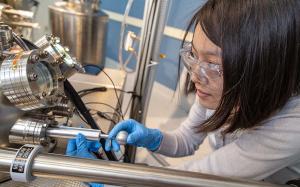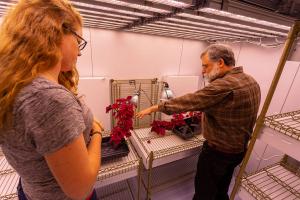
It happens every year. A number of eminent and promising scientists leave or turn down lucrative positions at prestigious institutions in global cities to come live in a small town of less than 50,000 in the rural center of Pennsylvania and join the faculty at Penn State. If it isn’t for Happy Valley’s rural charm, championship football tradition, or storied grilled stickies and Creamery ice cream, still the reasons are nonetheless compelling why they choose to come here, to a place that’s famously “four hours from everything,” to live and do research.
If you were to ask them, most—if not all—would tell you that Penn State’s collaborative and interdisciplinary environment was a major factor in their decision, that here they are empowered and encouraged to integrate across boundaries that hold back the work of their colleagues at other leading institutions. Penn State also is among the top universities in research funding—with a record $863M in expenditures just last year—and this, too, is a significant draw. But to really drive the forefront of discovery and innovation, scientists also need top-notch tools, and here at Penn State they have them.
Our researchers have access to an astounding array of cutting-edge instrumentation staffed by specialists in myriad techniques and applications. With such world-class capabilities and expert support, our scientists are able to study the very building blocks of life and matter—from organs, tissues, and cells to single molecules, atoms, and even elementary particles. Linked into state-of-the-art cyberinfrastructure, they can power through massive, highly complex data analyses, parsing human genome studies and multi- messenger astronomical observations and modeling evolution, global weather patterns, and the formation of planetary systems. Through collaborations with partners around the world, they have access to technologies that allow them to probe the depths of Earth and beyond: deep-diving submersibles, colossal telescopes, cosmic-particle detectors, even exoplanet-hunting satellites.
At University Park alone, the instrumentation fills over a dozen dedicated user facilities and many more labs and research centers across campus. The following infographic is a high-level overview of that instrumentation, focused on the premier technologies used by researchers in the Eberly College of Science and elsewhere at Penn State; it is non-exhaustive, but should provide enough information to whet the appetites of inquisitive readers, and there is no end to where that may lead.

2D Crystal Consortium-Materials Innovation Platform: A national user facility, supported by the National Science Foundation, focused on advancing the synthesis of novel two-dimensional (2D) materials for applications in next-generation electronics.

Automated Biological Calorimetry Facility: Specializes in high-throughput thermodynamic analysis of biological macromolecule binding and folding and protein and lipid quantification.

Genomics Core Facility: Provides next-generation sequencing and other, traditional genomic services that support studies ranging from human health to evolution.

Cryo-Electron Microscopy Facility: Built around the capabilities of Penn State’s one-of-a-kind FEI Titan/Krios microscope, a uniquely configured instrument supporting life sciences and materials sciences applications with incredible atomicresolution imaging.

Nuclear Magnetic Resonance Facility: Supports a wide range of applications, including characterizations of solid and soft materials, small molecules and polymers, and biomolecules such as proteins and nucleic acids, as well as metabolomics studies and drug discovery.

Institute for Cyberscience Advanced Cyberinfrastructure (ICS-ACI): Enables advanced simulations and statistical modeling, data analysis, data mining, and more, for a variety of studies.

Materials Research Institute: Provides open access to three integrated facilities for nano-and micro-scale fabrication, characterization, and computational modeling:
- Materials Characterization Laboratory (MCL): Enables a variety of characterizations with microscopy, spectroscopy, and macroscopic techniques, as well as advanced materials processing.
- Nanofabrication Laboratory: Provides world-class capabilities in materials deposition and growth, lithography, etching, and characterization.
- Materials Computation Center (MCC): Supports computer-based simulations of materials across various length and time scales.

Metabolomics Core Facility: Conducts mass spectrometry–based metabolomics studies on biofluids and tissue extracts to identify and quantitate metabolic byproducts (metabolites) and provide insights into the biological processes underlying their production.

Microscopy and Cytometry Facility: Enables a range of studies, with services spanning optical and electron microscopy, histology, flow cytometry, and cell sorting.

Parasitic Plant Facility: A USDA-regulated growth and containment facility that allows researchers to safely propagate and study parasitic plant species.

Pritchard Fluid Mechanics Lab: Enables researchers to study complex fluid mechanics and topology through analysis, numerical computations, and physical experiments—all in a single lab.

Proteomics and Mass Spectrometry Core Facility: Specializes in mass spectrometry–based identification and quantitation of metabolites and other small molecules, analysis of synthetic compounds, polymers, biomolecules, and mixtures, and protein identification.

X-Ray Crystallography Facility: Provides a range of services for crystallization and determination of the three-dimensional structures of proteins and other biological macromolecules.
